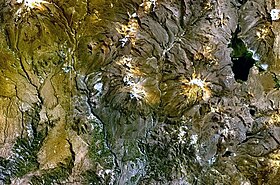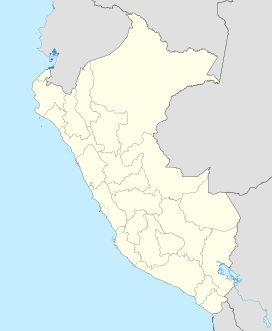Tutupaka
| Tutupaca | |
|---|---|

Tutupaca (upper left), Yucamane (center) and Lake Vilacota (on the right) as seen from above (NASA Landsat7 image)
|
|
| Highest point | |
| Elevation | 5,815 m (19,078 ft) |
| Coordinates | 17°01′35″S 70°22′18″W / 17.02639°S 70.37167°WCoordinates: 17°01′35″S 70°22′18″W / 17.02639°S 70.37167°W |
| Geography | |
| Geology | |
| Mountain type | Stratovolcanoes |
| Last eruption | 1802 |
Tutupaca is a twin volcano in Peru, about 5,815 metres (19,078 ft) high. It is located in the Tacna Region, Candarave Province, Candarave District. Tutupaca is situated northwest of Lake Vilacota and Yucamane volcano. The northern edifice is more strongly eroded and underwent a flank collapse. The volcano has postglacial lava flows and underwent a major historical eruption between 1787 and 1802. Historic records of the latest eruption were considered to be from the neighboring Yucamane volcano before being confirmed by recent geochronology work. The volcano is also active with fumaroles, one was reported on the northeastern flank in 1953. Debris avalanche deposits are mined for sulfur.
Tutupaca rises above a high plateau of 4,400 to 4,600 m (14,400 to 15,100 ft) mainly formed from sedimentary and volcanic material of Miocene-Pliocene age, and is formed from a basal edifice and two smaller ones constructed on top of it. This basal edifice, mostly of andesitic and dacitic composition and centered on the south of the two current edifices, was heavily affected by glaciation and hydrothermal alteration as well as a late ignimbrite eruption. Major moraines of probably Late Glacial Maximum lie in the surrounding valleys and on the basal edifice. The western (or northern) smaller edifice is a complex of lava flows and domes with Plinian eruptive activity, also affected by glacial erosion. One biotite was dated to 0.7 Ma ago. The eastern (or southern) edifice is formed by lava domes unaffected by glacial action, but is cut by a NE-open amphitheatre and containing the remnants of a summit crater. Several non-pristine lava flows are discernible. Two edifice failure events are noticeable on the southern edifice, an older channelized towards the east-southeast, and a more recent one towards the northeast. The river valleys Tacalaya and Callazas run beside the volcano complex, the latter separating it from the younger looking Yucamane. A major SE-NW-trending fault system is associated with the volcano and may be related to the formation of the amphitheatre.
...
Wikipedia

